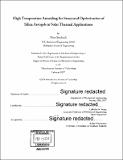| dc.contributor.advisor | Evelyn N. Wang. | en_US |
| dc.contributor.author | Strobach, Elise M. | en_US |
| dc.contributor.other | Massachusetts Institute of Technology. Department of Mechanical Engineering. | en_US |
| dc.date.accessioned | 2017-05-11T19:55:24Z | |
| dc.date.available | 2017-05-11T19:55:24Z | |
| dc.date.copyright | 2016 | en_US |
| dc.date.issued | 2017 | en_US |
| dc.identifier.uri | http://hdl.handle.net/1721.1/108914 | |
| dc.description | Thesis: S.M., Massachusetts Institute of Technology, Department of Mechanical Engineering, February 2017. | en_US |
| dc.description | Cataloged from PDF version of thesis. | en_US |
| dc.description | Includes bibliographical references (pages 59-60). | en_US |
| dc.description.abstract | Optically transparent, thermally insulating monolithic silica aerogel, with its high solar transmittance and low thermal conductivity, is well-suited for solar thermal applications, particularly concentrated solar power systems. The properties of silica aerogel are directly determined by the structure of the highly porous, interconnected silica network. By using high temperature annealing to control this structure post-synthesis, we were able to optimize the material to increase solar transmittance using an easy and scalable method. The changes caused by annealing were investigated with respect to both temperature and time to relate the structural change to the optical and thermal performance change. The temperature dependent study samples were annealed for 1 hour at various temperatures ranging from 400-1000 °C. The time-dependent studies used samples made from two silica aerogel chemistries and were annealed at two temperatures (400 °C and 600 °C). In general, lower temperatures and times have less overall change (slower change rates) than higher temperature or longer time annealing. Both annealing studies indicate optical performance has an optimum with respect to annealing time, and additional temperature or time negatively affects optical properties due to appreciable structural change. After the temperature annealing studies were used to understand general trends, the time dependent studies were used to maximize the properties of aerogel for CSP applications. The samples showed an increase in solar spectral transmittance of over 3% while the effective thermal conductivity was shown to increase by as much as 40%, indicating a need to optimize the annealing time for maximum performance. The properties of the characterized aerogels were used to demonstrate aerogel annealing optimization in a concentrated solar power receiver model operating at 400 °C. The model predicted a 1% receiver efficiency increase for an operating temperature of 400 °C by annealing for 24 hours, representing a significant gain in overall system efficiency. | en_US |
| dc.description.statementofresponsibility | by Elise Strobach. | en_US |
| dc.format.extent | 60 pages | en_US |
| dc.language.iso | eng | en_US |
| dc.publisher | Massachusetts Institute of Technology | en_US |
| dc.rights | MIT theses are protected by copyright. They may be viewed, downloaded, or printed from this source but further reproduction or distribution in any format is prohibited without written permission. | en_US |
| dc.rights.uri | http://dspace.mit.edu/handle/1721.1/7582 | en_US |
| dc.subject | Mechanical Engineering. | en_US |
| dc.title | High temperature annealing for structural optimization of silica aerogels in solar thermal applications | en_US |
| dc.type | Thesis | en_US |
| dc.description.degree | S.M. | en_US |
| dc.contributor.department | Massachusetts Institute of Technology. Department of Mechanical Engineering | en_US |
| dc.identifier.oclc | 986241384 | en_US |
